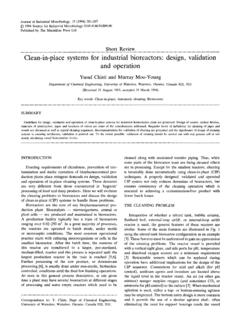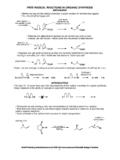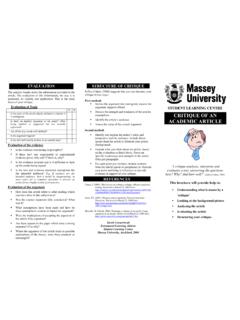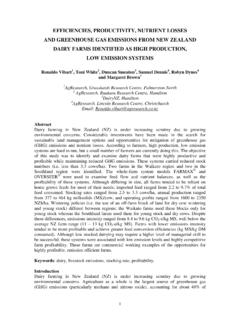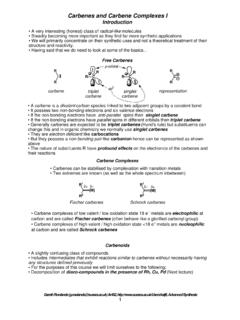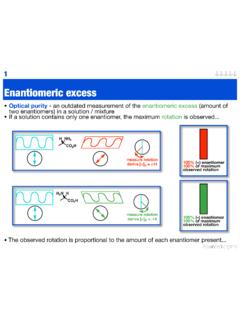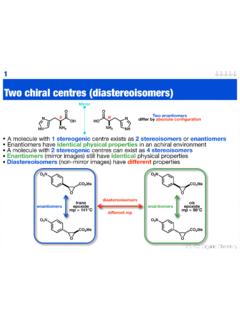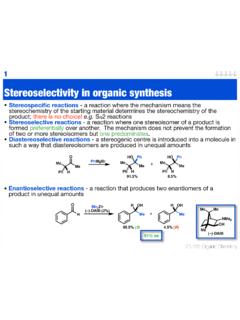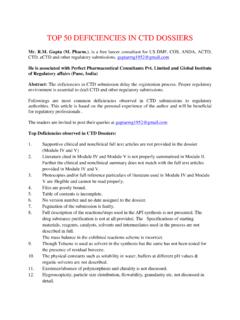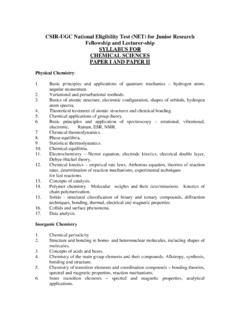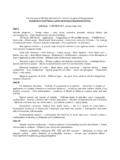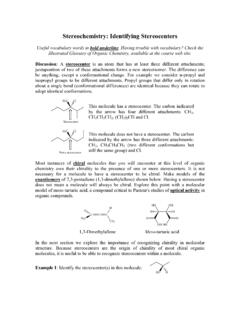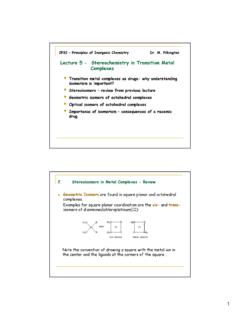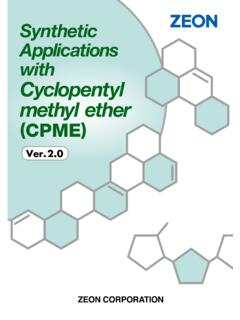Transcription of [3,3]-Sigmatropic rearrangements - Massey University
1 Organic ChemistrybXcHR2dRabXcHR2dRaXRR2dabcheatX R2R3R1XR1R3R2 [3,3]-Sigmatropic rearrangements A class of pericyclic reactions whose stereochemical outcome is governed by the geometric requirements of the cyclic transition state Reactions generally proceed via a chair-like transition state in which 1,3-diaxial interactions are minimised Many similarities to the aldol reaction Absolute stereochemistry - controlled by existing stereocentre (destroyed in rct)Relative stereochemistry - controlled by alkene / enolate geometry Organic ChemistryHMeMePhHMePhMe91%HPhMeMeMeHMePh 9%MeMePhCope rearrangement A very simple example of a substrate controlled [3,3]- sigmatropic rearrangement is the Cope rearrangement To minimise 1,3-diaxial interactions phenyl group is pseudo-equatorial Note.
2 The original stereocentre is destroyed as the new centre is formed This process is often called chirality transfer 21,3-diaxial interactions Organic ChemistryClaisen rearrangements One of the most useful sigmatropic rearrangements is the Claisen rearrangement and all it s variants3 Claisen rearrangementJohnson-Claisen rearrangementEschenmoser-Claisen rearrangementOH+OEtHg+OOHheatOH+MeOMeMeO OMeH+OOMeOOMeheatOH+MeNMe2 MeOOMeH+ONMe2 ONMe2heatIreland-Claisen rearrangementOH+ Organic ChemistryMeMeOMeNMe2 MeNMe2 MeOOMeMeMeOHMeH2 Lindlar MeMeMeNMe2 OHMeMeOMeNMe2 MeNMe2 MeOOMeNaNH3 MeMeOHMeMeMeMeOHMeMeMeOH Enantioconvergent synthesis Both enantiomers of initial alcohol can be converted into the same enantiomer of product This process (Eschenmoser-Claisen)
3 Shows the importance of alkene geometry4 SET reduction gives most stable alkeneheterogeneous hydrogenation leads to syn addition of H2 OHNMe2i-PrMeOHNMe2i-PrMeHHMe2 NOHMeHi-PrMe2 NOHMeHi-Prsame configurationMeHMeNMe2 OMe Organic ChemistryOHHOSiR3 MeMeOHHOSiR3 MeMeOOSiR3 MeMe1. LDA, THF/HMPA2. R3 SiClOMeMeOSiR3 OHMeOSiR3 MeHOOSiR3 MeMeOHMeOSiR3 MeH1. LDA, THF2. R3 SiClOMeOSiR3 MeOMeMeOIreland-Claisen reaction Enolate geometry controls relative stereochemistry Therefore, the enolisation step controls the stereochemistry of the final product As we saw earlier it is relatively easy to control enolate Organic ChemistrySubstrate control in Ireland-Claisen rearrangement In a similar fashion to the Cope rearrangement we saw earlier, the Ireland-Claisen rearrangement occurs with chirality transfer Initial stereogenic centre governs the conformation of the chair-like transition state Largest substituent will adopt the pseudo-equatorial position Once again.
4 The relative stereochemistry is governed by the geometry of the enolate6 OMeMeOHO91% ee1. LHMDS2. TMSClHOOTMSHMeOTMSMeHOOTMSHMeOTMSMeHO2 CMeOTMSMe98% syn91% eemethyl group is Organic ChemistryAuxiliary controlled rearrangement in total synthesis ( )-Malyngolide is an antibiotic isolated from the blue-green marine algae Lyngbya majuscula This synthesis utilises Enders' RAMP hydrazone as a chiral auxiliary to set up the quarternary centre Dieter Enders & Monika Knopp Tetrahedron 1996, 52, 5805 7 NNOMeOOLiTMPNNOMeOOLiLiAlH4 NNOMeOHOOMeOHMe( )7( ) Organic ChemistryOOHMeMe96% eewarmOOMeR*2 BMeEt3 NTol / hexane 78 COOHMeMe>97% eewarmOOMeMeR*2Bi-Pr2 NEtCH2Cl2 78 COOMeMe+NBNPhPhArO2 SSO2 ArBrChiral reagent control in the Ireland-Claisen rearrangement Funnily enough, it is possible to carry the reaction out under reagent control Although, it could be argued that this is just a form of temporary auxiliary control!
5 Enolate formation (enolate geometry) governs relative Organic ChemistryThe use of a chiral reagent in total synthesis Dolabellatrienone is a marine diterpenoid isolated from gorgonian octocorals such as Eunicea calyculata and other marine organisms This synthesis of dolabellatrienone relies on boron enolate chemistry to establish the stereochemistry of the final molecule E. J. Corey & Robert S. Kania, J. Am. Chem. Soc. 1996, 118, 12299 OMeMeMeONBNPhPhBrSO2O2 SCF3F3CF3 CCF3 MeMeCO2 HHMeMeMeHMeOMeMedolabellatrienoneNi-PrN( i-Pr)2(i-Pr)2N86%>98% Organic ChemistryChiral catalyst control in the Ireland-Claisen rearrangement It is also possible to perform the reactions under chiral catalyst control Presumably, the Lewis acid coordinates to the oxygen & influences the reactive conformation thus controlling enantioselectivity10 OPhSiMeMeMeHOSiMe3 PhOPhSiMe3 MeAl(OR*)2 OOAlMeSiMe2t-BuSiMe2t-BuMeAl(OR*)
6 2 = Organic ChemistryHMeOHHHHMeHOHHHMeMe HOMe98%de98%eeMeOBuLi 85 CMeMeHHHOHHMeH HOMe98%deHHOHHMeHOMeBuLi 85 C1122311223 OZHHOZOZBaseOZ2,3-Wittig rearrangement Useful rearrangement allowing good 'chirality transfer' Requires method for formation of anion - either acidic proton (Z=electron withdrawing group) or metal-functional group exchange Driving force is stability of alkoxide (although other elements can be ) Transition state debatable but useful model is the 'envelope' based on chair11 Largest substituents adopt pseudo-equatorial Organic ChemistryEnantioselectivity in the 2,3-Wittig rearrangement Reagent control utilising boron reagent seen in both aldol & Claisen reactions Chiral catalysis is far less developed in this area One example is given below:12 OMeCO2Me+NBNPhPhPhO2 SBrSO2 PhEt3 NOMeR2 BOOMeMeOMeOOBNNSO2O2 SPhPhPhPh HOMeCO2Me66%de96%eeOArR2*RNPh(CH2)2 OOArcat (20mol%)MeOH, rt, 5d75%60%ee (dr 2.)
7 1)Ph(CH2) Organic Chemistry[2,3]-aza-Wittig reaction in total synthesis Aza-Wittig reaction is less common as normally no driving force Here relief of ring-strain accelerates reaction Utilised in the synthesis of indolizidine 209B from Dendrobates pumilio or the strawberry poison dart frog by Jens hman & Peter Somfai, Tetrahedron, 1995, 51, 974113C5H11 MeNCO2t-BuLDA97%NC5H11 HHMeHLiOOt-BuNHC5H11CO2t-BuMeNC5H11 Meindolizidine 209B
